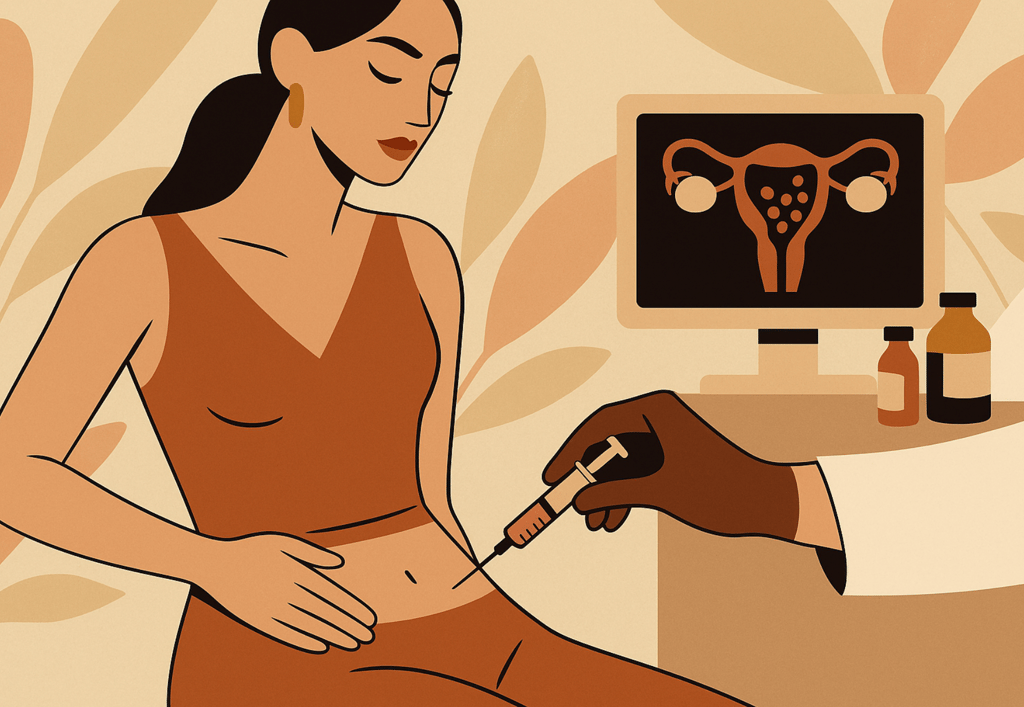Stimulation Phase Explained
Understand the IVF stimulation phase: daily injections, scans, follicle tracking, and how your clinic monitors your body during treatment.
WHAT IS IVF?


The IVF Process Step by Step → Understanding IVF
When people first hear about IVF, the “stims” phase — those daily injections and frequent clinic visits — can feel like the biggest hurdle. It’s the first major stage of active treatment, the one where you begin taking control of your cycle with medication, and the one most patients find the most physically and emotionally demanding.
In this post, we’ll break down exactly what happens during the stimulation phase, how your body is monitored, and what you can expect day by day. No jargon, no judgment — just a calm, UK-focused guide.
What Is the Stimulation Phase?
The stimulation phase (or “stims”) is the period in your IVF cycle where fertility drugs are used to encourage your ovaries to mature more follicles — and hopefully produce more eggs — than they would in a natural cycle.
In a typical natural cycle, one follicle grows, one egg matures, and one egg is released. With IVF, the goal is different: we want multiple eggs so the embryologists can fertilise several, watch them develop, and select the strongest embryos. More eggs doesn’t always mean more babies, but it increases the chances of finding a healthy embryo.
This phase usually lasts 8–12 days, although it can be slightly shorter or longer depending on how your body responds.
The Medications You’ll Take
Every clinic uses slightly different protocols, but the most common drugs in the UK include:
FSH (Follicle Stimulating Hormone) — The main stimulation drug (brand names like Gonal-F, Bemfola, Menopur). These are daily injections under the skin, usually into your lower stomach.
LH (Luteinising Hormone) or HMG (Human Menopausal Gonadotropin) — Sometimes combined with FSH to support follicle growth.
GnRH Antagonist — A second injection (often Cetrotide or Orgalutran) added later in the cycle to prevent you from ovulating too early.
Trigger Injection — A final timed shot (usually hCG or Lupron) that matures your eggs before collection.
Most patients inject once or twice a day, typically at the same time every evening. Nurses will teach you how to prepare and inject safely, and you’ll usually have a sharps bin to collect used needles for disposal.
How the Monitoring Works
Because everyone responds differently, close monitoring is essential. Your clinic will track your progress through:
Ultrasound Scans — Usually every 2–3 days, performed internally (transvaginal). These scans measure the size and number of growing follicles.
Blood Tests — To monitor your oestrogen levels, which rise as follicles grow.
Dose Adjustments — If your follicles are growing too quickly or too slowly, your doctor may change your medication dose to balance things out.
Most patients have 3–5 monitoring appointments in total during stimulation, and you’ll need to be flexible — clinics sometimes call you in on short notice based on your results.
How Your Body Feels
The stimulation phase is different for everyone, but some of the most common physical effects include:
Bloating and Pressure — Your ovaries can grow significantly as multiple follicles develop, which can feel heavy or uncomfortable.
Mild Cramping — As your ovaries stretch.
Tenderness or Bruising — At injection sites.
Emotional Swings — Oestrogen levels rise rapidly, which can heighten emotions.
Some people continue their normal routines — working, exercising lightly — while others need to slow down, especially in the later days when bloating can make even walking uncomfortable. Most clinics advise avoiding high-impact exercise and intercourse to reduce the risk of ovarian torsion (a rare but serious twisting of the ovary).
The Goal: Trigger and Egg Collection
When enough follicles reach the right size (usually 17–20mm), your clinic will schedule your trigger injection. This is carefully timed — usually around 36 hours before your egg collection procedure.
After your trigger, you’ll stop your daily stimulation injections, get one more scan or phone call to confirm everything is on track, and prepare for your egg retrieval day.
Emotional Realities of Stims
This phase can feel relentless: daily needles, constant clinic trips, the pressure of follicle numbers, and the looming anxiety about whether it’s all “working.” Many people find the waiting between scans to be the hardest part, as there’s little you can control beyond showing up and taking your meds.
Some tips that may help:
Ask questions — Don’t be afraid to call your nurse if you’re unsure about timings or doses.
Plan your schedule — Work and life often need to flex around scans.
Stay hydrated and rest — It can ease bloating and discomfort.
Lean on support — Partners, friends, or online communities can help you feel less isolated.
Frequently Asked Questions
How many eggs should I expect?
There’s no magic number. Some people get 5, others 25. Success depends more on egg and embryo quality than sheer quantity.
Does more medication mean more eggs?
Not always. Your clinic tailors your dose to your age, weight, and ovarian reserve. High doses don’t guarantee better results and can increase the risk of side effects.
What is OHSS and should I worry?
Ovarian Hyperstimulation Syndrome is a rare but serious reaction where your ovaries swell and leak fluid. Clinics monitor closely to reduce this risk and may freeze all embryos if you’re at high risk.
Related Reading
© 2025. All rights reserved.
